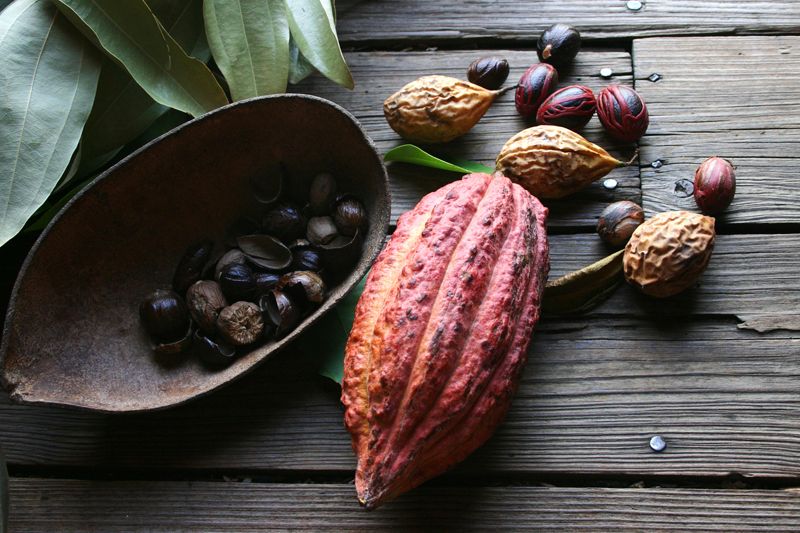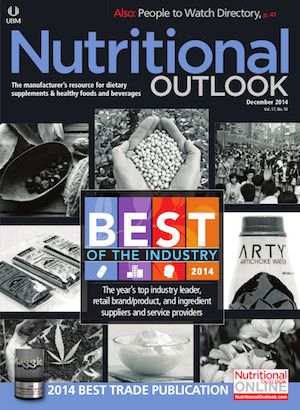Nutritional Outlook's Best of 2014: DianaPlantSciences
In 2014, the company made plant cell culture technology a commercial reality.

Imagine that we had a way to dive down into a plant at a cellular level and target a bioactive that interests us for some health or wellness reason. Then imagine that we could get that plant’s cells to pump out that bioactive-plus any companion compounds that might participate in its beneficial effects-on a commercially relevant scale. Then imagine that we could do all this without investing the resources or creating the waste that would come with growing that plant in a field or greenhouse, harvesting it, and extracting the target compound the “old-fashioned” way.
The team at DianaPlantSciences (DPS; Portland, OR) isn’t just imagining this scenario; they’re working it in their labs every day. And they’ve been doing so-using what’s known as plant cell culture technology-for the past four years. The technology “bridges the gap between agricultural products and pharmaceutical ones,” says company president Marc Philouze, and the result is an ingredient with “a high content of target phytoactives while retaining the diversity and complexity of the elements inherent to the traditional plant.”
So what is plant cell culture technology? Philouze describes it as the controlled growth and reproduction of plants, plant tissues, and/or plant cells for the purpose of zeroing in on those cells that exhibit an optimal concentration and distribution of whatever naturally occurring phytoactive you’re looking for.
And it’s a technology whose time has come, given the pressures facing not just industry, but the planet. Compared to traditional agricultural methods used to produce plant sources of bioactives, the technology leaves a vanishingly small footprint. For example, it requires minimum water use and no pesticide application. And because the plant cells produce a precisely prescribed amount of actives within each cell, there’s no need to harvest a whole plant and extract one compound, a process that’s labor, energy, and resource intensive and leaves behind wasteful byproducts.
By proceeding in a controlled environment shielded from environmental variability, plant cell culture technology “enables the growth of plant cells without ever having to worry about how factors such as rainfall, drought, light, and pests affect yield and consistency,” Philouze adds-no small matter in our changing climate. And because it renders pesticide exposure or adulteration moot, it makes the task of accounting for transparency, identity, and traceability much easier.
So if plant cell culture technology is, in a word, efficient, one thing it isn’t is genetic modification. Plant cell culture technology introduces no traits and generates no products that the plant wouldn’t possess or produce naturally. Rather, Philouze explains, “The process repeatedly selects the groups of cells that display the targeted characteristics, generation after generation.” Think of it as 21st-century plant breeding, amplifying desirable attributes not through painstaking matches but through a proprietary technology that permits high-throughput screening of multiple cell lines.
Novel as it seems, the technology has actually been around for decades, Philouze says, but was held back because it “had been difficult to commercialize due to lack of reproducibility, scalability sensitivity, and selectivity.” And that’s where his company makes a difference.
As Philouze tells it, DPS was founded by “a handful of scientists focused on producing ingredients from plant cell culture technology.” Some had been working with the technology for close to 30 years, and their cumulative expertise not only gave the firm uncommon familiarity with cell-line selection-all the better to hone in on the best choices for targeted actives-but, says Philouze, translated into “a rare understanding of metabolic pathways and the ability to unlock them to attain active concentrations far in excess of the plant performance in the wild, without compromising its natural origin.”
This mastery of key metabolic pathways allows the team to focus on secondary metabolites that protect the plant cell but don’t directly act in the plant’s growth, development, or reproduction. This point may sound recherché to layfolk, but to Philouze and colleagues, it equals access to “many powerful compounds, such as potent antioxidants,” that fall into the secondary-metabolite category.
As proof of the technology’s benefits and the company’s technical savvy, DPS launched its first commercial product, Cocovanol Cocoa Actives. The health benefits of cocoa have sparked no dearth of chatter, and Cocovanol delivers high polyphenolic content without extraction issues, sustainability quandaries, bitterness, caffeine or theobromine (the bitter alkaloid of the cacao plant), or-crucially-excess calories and fat.
Also in development is ActivBerry bilberry, whose procyanidin profile is impossible to replicate via traditional extraction from the bilberry fruit, says Philouze. Moreover, the product can claim sustainable sourcing and a neutral creamy color that, unlike most berry extracts, doesn’t interfere with the appearance of colorless applications, such as skin creams.
That’ll keep the company busy in 2015, as will efforts to educate consumers and manufacturers about plant cell culture technology. “We developed the website www.plantcellculture.com to serve as an educational platform,” Philouze points out, and the company prepared several white papers and backgrounders to help the public understand the technology’s safety and utility in providing “a real solution for some of industry’s challenges.”
Fortunately, the learning curve isn’t very steep. “Once people understand the technology and its benefits, the interest soars right away,” Philouze says, adding that “DianaPlantSciences also offers companies partnership opportunities in developing exclusive novel ingredients for maximum differentiation in the marketplace.”
Since the company’s founding, internal interest certainly hasn’t flagged. “Some of the company’s scientists have been working with their cell lines from the very beginning and think of them like their babies,” Philouze says. “So it’s an exciting technology for the market and the industry, and it’s still very exciting for us.”
<<Previous Next>>
Photo © iStockphoto.com/stormarn

The Nutritional Outlook Podcast Episode 39: Nutritional Outlook's Ingredients to Watch in 2025
February 25th 2025In this episode, Nutritional Outlook interviews Scott Dicker, market insights director from market researcher SPINS, about ingredients and product categories nutraceutical and nutrition product manufacturers should watch in 2025.




















